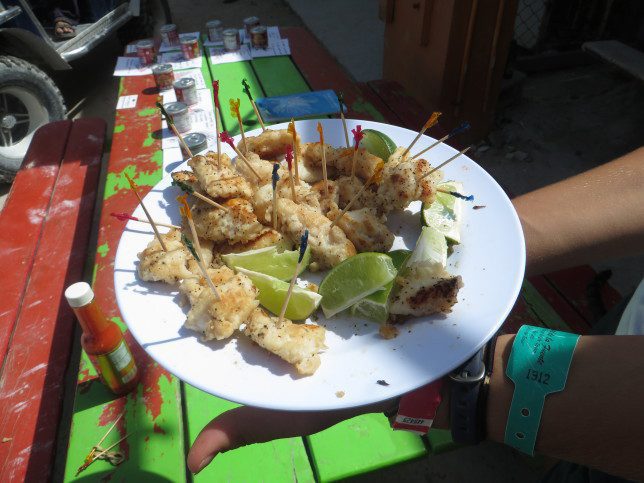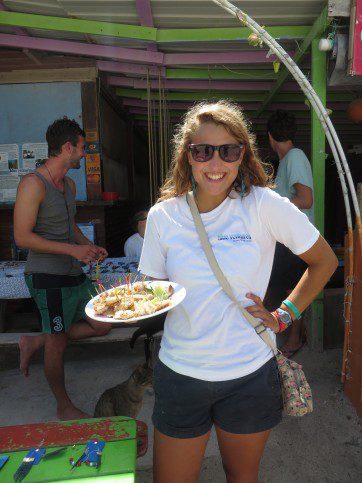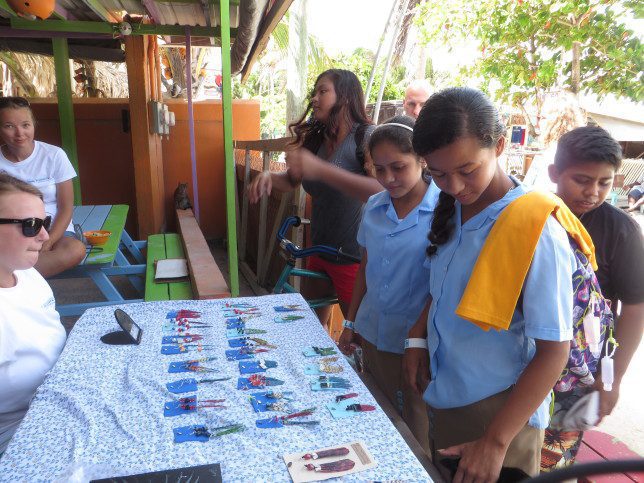By Winnie Courtene-Jones, Field Scientist, Belize
Since their arrival in Belize in 2008, lionfish have dramatically increased in numbers and spread throughout the country’s waters, devastating the World Heritage listed Belize Barrier Reef. What better way than to help tackle the lionfish invasion than by encouraging the consumption of this delicious fish!
Ask anyone what they know about lionfish and undoubtedly their first response will be that they have venomous spines – look but don’t touch… But what some people don’t realise is that their meat is quite tasty and not poisonous! For those who don’t know, venom is always injected (whether via bites, stings or spines) while poison has to be ingested (i.e. eaten!) so lionfish are perfectly safe to eat.

Delicious lionfish samples
Since 2011, we’ve held regular safe-handling workshops for fishers, and taster events with the public in Sarteneja, where lionfish is now a regular item on restaurant and household tables. Fully addressing the varied obstacles of the lionfish problem in the different locations, such as making sure that both demand and supply of lionfish meat align, is one of the essential first steps to replicating the Sarteneja success story countrywide. It is time to take the fight against the lionfish further afield.
Three teams formed to carry out social questionnaires for restaurants nationwide; Shawn led the San Pedro team, Meira the Belize City team and myself the Caye Caulker team. The questionnaires were well received by the restaurants and returned some interesting results. In all the locations, most of the people asked, still think that lionfish isn’t safe to eat – showing that there is still a great need for lionfish outreach efforts across Belize. A number of restaurants said they would be interested in trialling lionfish as a special and the main factor which would encourage them to serve it regularly is customer demand.

Who could resist lionfish when its served by our lovely volunteer Jamie?
Of the 18 restaurants interviewed in Belize City only one sold lionfish already, whereas in the more touristy locations of San Pedro and Caye Caulker, four out of 25 and two out of 20 restaurants respectively sold lionfish. Regardless of location, those restaurants which sold lionfish said that when it was on their menus it was their best seller! There is still work to be done to get lionfish seen on more menus across the country and to ensure that supply and demand meet, however it was encouraging to hear about its success from the restaurants that already sold it.

Alana, Chris, Nick and Sarah at the booth in Caye Caulker
The next day we held a lionfish taster event at the ‘Enjoy’ restaurant in Caye Caulker to raise the profile of this tasty (and safe!) fish. There was a buzz of activity in the air, and not even the morning rain could dampen anyone’s spirits (pun intended). Not only were we providing information about lionfish, but we were offering free lionfish tasters, expertly cooked by our wonderful volunteers. While initially some people may have been apprehensive about trying this notorious fish, they soon came around to the idea and the samples went down a treat. We also had a wide selection of lionfish jewellery for sale, made by the women of Sarteneja and by the accomplished lionfish artist from southern Belize, Palovi. The jewellery captured the imagination of those who saw them and people were surprised to see the patterns and beauty of the fins.

Local children admiring the lionfish earrings
The response in Caye Caulker was great and we left feeling very positive. Through events like this it is really possible to demonstrate to consumers and restaurants the market potential for lionfish; the more customers talk about lionfish and ask for it in restaurants the more likely the restaurant is to start selling it. This encourages local fishermen to catch them, in turn helping with the control of this invasive on the Belizean reefs. All steps in the right direction.
A huge thank you to all of our volunteers and Enjoy restaurant for making this such a successful day!

